Just about every weekend when I was quite small one of my parents–most often my mother — and I would take a bus ride just to see what was out there. I didn’t know it at the time but this was the first brick in the foundation that would be Forgotten New York. In Bay Ridge, Brooklyn, we had our pick of buses, some now eliminated, some have changed routes. For example we had the B16, Ft Hamilton Parkway to Prospect Park…
…or there were the B63 (5th Avenue) and B37 (3rd Avenue) both of which ran to the downtown Brooklyn shopping district, where A&S was the queen of Fulton Street. I later (1975-79) used both buses to go to St Francis College and my college job in the Brooklyn Business Library. During the summers, we would take the B64 which used 86th Street and Bath Avenue to get to Coney Island. The B64, in the early 1960s, was the bastion of the boxy Mack buses rather than the somewhat more diminutive GM Old Looks, which both succumbed to the GM Fishbowls beginning in 1960. The B64 no longer goes directly to Coney Island, and Bay Ridgeites now must transfer at Bay Parkway if they want to bus it to the now-diminishing Coney. If my parents were in the mood, we would even transfer from the B16 to the B35 bus at 39th Street, which rumbled directly into the heart of Flatbush and ultimately, Brownsville, which we rarely visited since in the 1960s, it was deteriorating. In that era, a paper transfer was required to ride the second bus, and even those had time limits..
On one of the excursions on the B16, we alit at the end of the line which then was Ocean and Woodruff Avenues a block from Prospect Park, and instead of visiting the Park, as we mostly did, we headed south instead, probably to visit the gi-normous candy store then found on the SE corner of Flatbush and Caton. We were wandering about, when I remembered that one of the cast-iron posts with humpbacked street signs (common till 1962 or 1963, thereabouts) read “Tennis Court”, which I though was quite clever. There are plenty of NY streets called “Court” and I thought whoever named the street was a punster extraordinaire. It never occurred to me that the street was named for an actual tennis court, which I only discovered a few years ago. I have never played tennis — it requires quite a bit of running about, and white is not my color.

There is indeed a tennis court — more than one — at Tennis Court, but their presence is unknown to neighborhood visitors. The Knickerbocker Field Club is an exclusive tennis club established in 1889, open only to “KFC” members — the courts are well obscured behind East 18th apartment buildings, as this aerial google picture shows. Tennis Court was, and is, the road that takes traffic to Ocean Avenue west to the club entrance. Here, we see the tennis courts bounded by the apartment building and by the Brighton BMT line, currently [2011] served by B and Q trains.
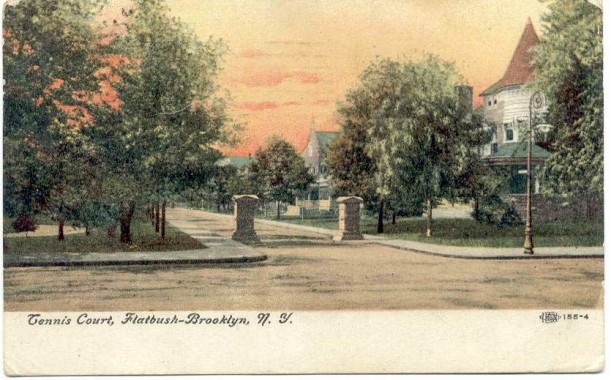
 The postcard above, from about 1910, shows a mansion-lined, tree shrouded Tennis Court. I don’t know if it depicts the East 18th Street end or the Ocean Avenue end, though.
The postcard above, from about 1910, shows a mansion-lined, tree shrouded Tennis Court. I don’t know if it depicts the East 18th Street end or the Ocean Avenue end, though.
At left is an excerpt from an 1890 atlas, and its shows a well-established Tennis Court (I have marked present streets. Oddly, it doesn’t show the actual tennis courts, which are between the railroad and East 18th just south of Tennis Court. The yellow square marks a wood building that is the Knick’s original clubhouse, which I show in the title card (also see below). That clubhouse was damaged by arson in 1988 and the club built a new clubhouse in its place.
Today the only hint of the tennis club’s presence is the sign over the parking lot (which also opens into the courts area) on East 18th.
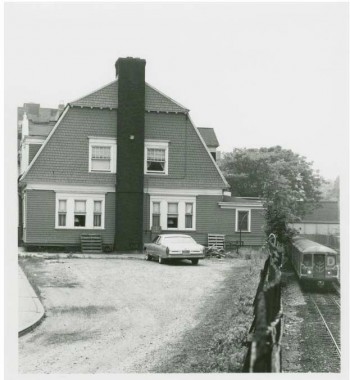 At left is a 1978 view of the original clubhouse, and at right, an R-40 car which was at the time using very large signs indicating the line in the front.
At left is a 1978 view of the original clubhouse, and at right, an R-40 car which was at the time using very large signs indicating the line in the front.
The Knickerbocker Field Club’s website does give you a look at the courts, as well as contact information. Christopher Gray’s 2008 article in the NY Times also provides a rare view. photo from NYPL archives
What about the rest of Tennis Court? In the opening decades of the 20th Century it lost its rural flavor, as huge apartment buildings were constructed on both sides of it and also along the north-south streets — even in front of the Knickerbocker.
The largest of the apartments along Tennis Court is the monumental Chateau Frontenac, meant perhaps to evoke comparisons with the original Chateau Frontenac, a grand hotel in Quebec City, Quebec (which I visited in 1972 and have very little memory of, at this remove.) There’s all manner of creature carvings, from dragons to hedgehogs to howling monks.
ForgottenFan Elliot Nesterman: the carvings on Chateau Frontenac are emblems of the French royal house. The dragon looking thing is an heraldic salamander, the badge of Francois I. Above it is carved the collar of the Order of St. Michael. The porcupine is the badge of Francois’s father Louis XII. It is behind a shield of the royal arms, a blue field with three gold fleur-de-lys, surmounted by a royal crown.
4/21/11

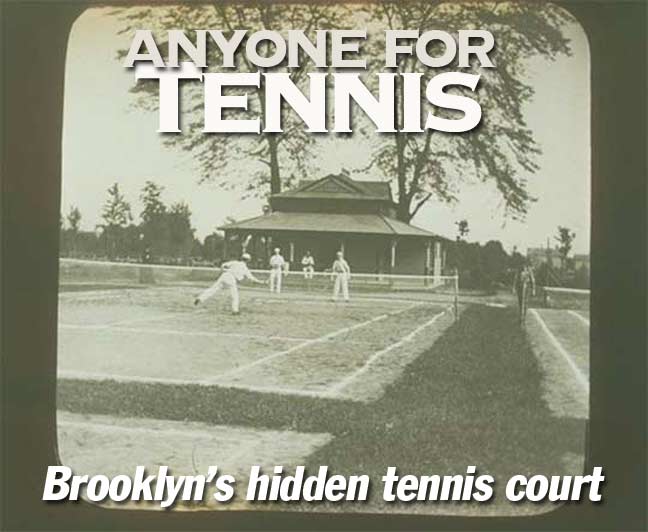

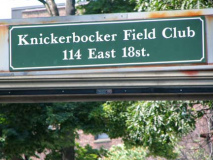
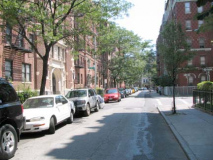
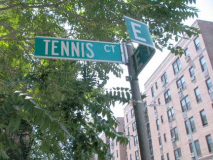
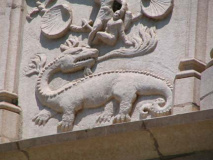
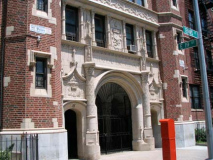
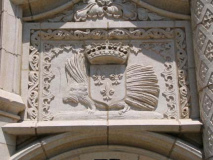
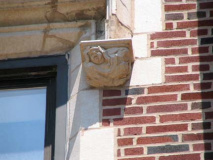
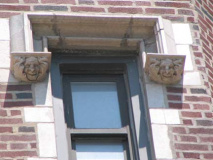
1 comment
[…] active member of the community, and was one of several prominent tennis enthusiasts who founded the Knickerbocker Field Club of Flatbush in the winter of 1889. The club was located just west of Tennis Court (love it!), between East 18th […]
Comments are closed.